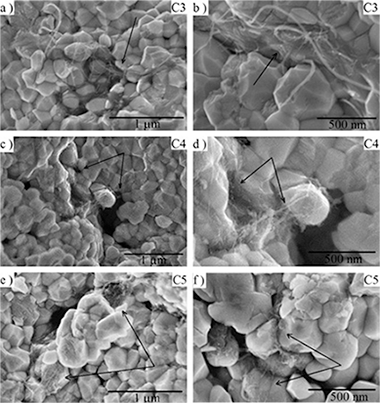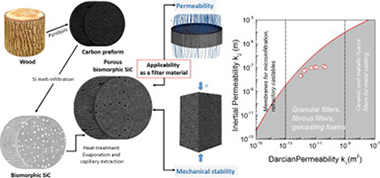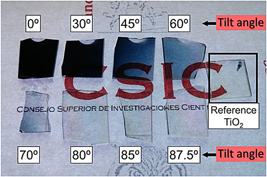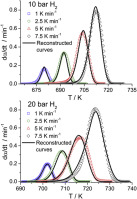Artículos SCI
2016
2016
Reactividad de Sólidos
Enhanced carbon nanotube dispersion in 3YTZP/SWNTs composites and its effect on room temperature mechanical and electrical properties
Gallardo-Lopez, A; Morales-Rodriguez, A; Vega-Padillo, J; Poyato, R; Munoz, A; Dominguez-Rodriguez, AJournal of Alloys and Compounds, 682 (2016) 70-79
Show abstract ▽

In this work, several modifications of the colloidal processing technique and spark plasma sintering (SPS) to prepare yttria tetragonal zirconia composites (YTZP) with single walled carbon nanotubes (SWNT) have been tested with the aim of eliminating SWNT agglomerates. These modifications include high versus low energy ultrasonic agitation during colloidal processing, lyophilization of the 3YTZP/SWNT slurry and electrical insulation during sintering of the composites. Semi-quantitative microstructural characterization of the carbon nanotube distribution in the sintered composites showed that high energy ultrasonic agitation reduces drastically agglomerate size. Lyophilization of the mixed suspensions avoids SWNT bundle size growth. Combination of both produces an enhanced carbon nanotube network distribution along the grain boundaries (GB) due to the absence of carbon nanotube agglomerates and to a limited SWNT bundle size. This results in an increase of the real SWNT content in the GBs up to nominal SWNT content and therefore an enhanced SWNT efficiency in the composites. The agglomerate-free highly-dispersed composites exhibit a decrease in density together with grain size refinement, a decrease in room temperature hardness, an increase in flexural strength and a most significant increase in room temperature electrical conductivity. Improved SWNT distribution also lowers electrical percolation threshold to a very low level in SWNT ceramic composites, <1 vol% SWNT.
Octubre, 2016 | DOI: 10.1016/j.jallcom.2016.04.262
Química de Superficies y Catálisis
Liquid-phase oxidation with hydrogen peroxide of benzyl alcohol and xylenes on Ca-10(PO4)(6)(OH)(2) - CaWO4
Dominguez, MI; Cojocaru, B; Tudorache, M; Odriozola, JA; Centeno, MA; Parvulescu, VIComptes Rendus Chimie, 19 (2016) 1156-1165
Show abstract ▽
A W-containing apatite (W/HAp) catalyst was prepared following a hydrothermal synthesis route and served as a model catalyst. Crystallographic analysis indicated that the resulting material contained hydroxyapatite, Ca10-3xWx(PO4)(6)(OH)(2), W-hydroxyapatite, calcium tungstate, CaWO4, and tricalcium phosphate, Ca-3(PO4)(2). The catalyst was investigated in liquid phase oxidation of benzyl alcohol and xylenes using hydrogen peroxide as an oxidant. For comparison, commercial calcium phosphate, hydroxyapatite and CaWO4 were tested in the same reaction. Calcium phosphate and hydroxyapatite appeared as inactive and decomposed hydrogen peroxide non-selectively. A moderate activity but low hydrogen peroxide efficiency was observed for the CaWO4 phase. In contrast, the W/HAp catalyst showed a reasonable activity and a better hydrogen peroxide efficiency in the oxidation of benzyl alcohol and xylenes. This new W/HAp catalyst showed, after six cycles, losses of the activity below 15% compared to the fresh catalyst with no effect on the selectivity. It is noteworthy that ICP-OES analyses showed no tungsten leaching that is the main advantage of this catalyst.
Octubre, 2016 | DOI: 10.1016/j.crci.2015.10.013
Materiales de Diseño para la Energía y Medioambiente
Permeability and mechanical integrity of porous biomorphic SiC ceramics for application as hot-gas filters
Gomez-Martin, A.; Orihuela, M. P.; Becerra, J. A.; Martinez-Fernandez, J.; Ramirez-Rico, J.Materials & Design, 107 (2016) 450-460
Show abstract ▽

Biomorphic SiC is a biotemplated material fabricated by Si melt-infiltration of carbon preforms from wood pyrolysis. In this work, porous bioSiC ceramics from five different wood precursors, with porosities between 45 and 72% were studied for their feasibility in filtering applications.
Gas permeability and mechanical stability were investigated as a function of the microstructure of the starting wood precursor. Air-permeation performance at room temperature was measured for a range of flow rates, and the permeability constants were assessed by fitting of Forchheimer's equation to the experimental data. Darcian permeabilities were achieved in the range 10− 11–10− 12 m2, while inertial terms were in the range 10− 7–10− 8 m, showing a correlation with the average pore size and orientation of the larger channels. Regarding the mechanical stability, maximum compressive strength values were reached in the range of 3–115 MPa.
These results improve our understanding of the ways in which the microstructure influences permeability and mechanical robustness, enabling the device requirements to be tailored by selecting the wood precursor. It was also shown that these materials are promising for hot-gas filtering applications.
Octubre, 2016 | DOI: 10.1016/j.matdes.2016.06.060
Nanotecnología en Superficies y Plasma
High-Rate Deposition of Stoichiometric Compounds by Reactive Magnetron Sputtering at Oblique Angles
Rafael Alvarez, Aurelio Garcia-Valenzuela, Carmen Lopez-Santos, Francisco J. Ferrer, Victor Rico, Elena Guillen, Mercedes Alcon-Camas, Ramon Escobar-Galindo, Agustin R. Gonzalez-Elipe, Alberto PalmeroPlasma Processes and Polymers, 13 (2016) 571-576
Show abstract ▽

Target poisoning in reactive magnetron sputtering deposition of thin films is an undesired phenomenon, well known for causing a drastic fall of the process efficiency. We demonstrate that when this technique is operated at oblique angles, films with composition raging from pure metallic to stoichiometric compound can be grown in non-poisoned conditions, thus avoiding most of the associated drawbacks. We have employed amorphous TiOx, although the presented results can be easily extrapolated to other materials and conditions. It is found that the proposed method improves 400% the growth rate of TiO2 thin films.
Octubre, 2016 | DOI: 10.1002/ppap.201600019
Reactividad de Sólidos
Magnesium hydride for energy storage applications: The kinetics of dehydrogenation under different working conditions
Perejon, A; Sanchez-Jimenez, PE; Criado, JM; Perez-Maqueda, LAJournal of Alloys and Compounds, 681 (2016) 571-579
Show abstract ▽

A new approach to the kinetics of magnesium hydride dehydrogenation is considered. A model able to predict the dehydrogenation under different experimental conditions has been proposed. A new combined kinetic analysis method, which considers the thermodynamic of the process according to the microreversibility principle, has been used for performing the kinetic analysis of data obtained under different thermal schedules at hydrogen pressures ranging from high vacuum up to 20 bar.
The kinetic analysis shows that the dehydrogenation mechanism of magnesium hydride depends on the experimental conditions. Thus, the reaction follows a first order kinetics, equivalent to an Avarmi-Erofeev kinetic model with an Avrami coefficient equal to 1, when carried out under high vacuum, while a mechanism of tridimensional growth of nuclei previously formed (A3) is followed under hydrogen pressure. An explanation of the change of mechanism is given. It has been shown that the activation energy is closed to the Mg-H bond breaking energy independently of the hydrogen pressure surrounding the sample, which suggests that the breaking of this bond would be the rate limiting step of the process. The reliability of the calculated kinetic parameters is tested by comparing simulated and experimental curves.
Octubre, 2016 | DOI: 10.1016/j.jallcom.2016.04.191
- ‹ anterior
- 211 of 420
- siguiente ›














